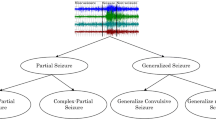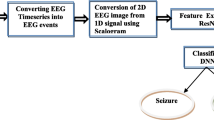Abstract
In this study, it has been intended to analyze Electroencephalography (EEG) signals by Wavelet Transform (WT) for diagnosis of epilepsy, to employ various Artificial Neural Networks (ANNs) for the signals’ automatic classification. Furthermore, carrying out a performance comparison has been aimed. Three EEG signals have been decomposed into frequency sub bands by WT and the feature vectors have been extracted from these sub bands. In order to reduce the sizes of the extracted feature vectors, Principal Component Analysis (PCA) method has been applied when necessary and these feature vectors have been classified by five different ANNs as either epileptic or healthy. The performance evaluation has been carried out by conducting ROC analysis for the used ANN models that and their comparisons have also been included.























Similar content being viewed by others
References
Motamedi, G., and Meador, K., Epilepsy and cognition. Department of Neurology, Georgetown University School of Medicine, Washington, 2003.
Faught, E., “Epilepsy case studies”, USA. Neurol. Clin. 24:291–307, 2006.
Blume, T. W., Diagnosis and management of epilepsy. CMAJ 168(4):441–448, 2003.
Beach, R., and Reading, R., The importance of acknowledging clinical uncertainty in the diagnosis of epilepsy and non-epileptic events. Arch. Dis. Child. 90:1219–1222, 2005.
Noachtar, S., and Rémi, J., The role of EEG in epilepsy: A critical review. Epilepsy Behav. 15:22–33, 2009.
Tzallas, A. T., Tsipouras, M. G., and Fotiadis, D. I, Automatic seızure detectıon based on tıme-frequency analysıs and ARTIfiCIAL neural networks. Hindawi Publishing Corporation Computational Intelligence and Neuroscience Vol. 2007, Article ID 80510, 13 pages.
Patnaika, L. M., and Manyam, O. K., Epileptic EEG detection using neural Networks and post-classification. Comput. Methods Programs Biomed. 91:100–109, 2008.
Subaşı, A., Epileptic seizure detection using dynamic wavelet network. Expert Systems Appl. 29:343–355, 2005.
Ebrahimi, F., Mikaeili, M., Estrada, E., Nazeran, H., and Member, S., Automatic sleep stage classification based on EEG signals by using neural networks and wavelet packet coefficients. 30th Annual International IEEE EMBS Conference Vancouver, British Columbia, Canada, August 20–24, 2008.
Subaşı, A., EEG signal classification using wavelet feature extraction and a mixture of expert model. Expert Systems Appl. 32:1084–1093, 2007.
Kannathal, N., Puthusserypady, S. K., and Min, L. C., Elman neural networks for dynamic modeling of epileptic EEG. Proceedings of the 28th IEEE EMBS Annual International Conference New York City, USA, Aug 30–Sept 3, 2006.
Kıymık, K., İnan, G., Dizibüyük, A., and Akın, M., Comparison of STFT and wavelet transform methods in determining epileptic seizure activity in EEG signals for real time application. Comput. Biol. Med. 35(7):603–616, 2004.
Subaşı, A., and Erçelebi, E., Classification of EEG signals using neural network and logistic regression. Comput. Methods Programs Biomed. 78(2):87–99, 2005.
Mohseni, H. R., Maghsoudi, A., and Shamsollahi, B., Seizure detection in EEG signals: A comparison of different approaches. Biomedical Signal and Image Processing Laboratory (BiSIPL), Sharif University of Technology, Tehran, 2006.
Jahankhani, P., Kodogiannis, V., and Revett, C., EEG signal classification using wavelet feature extraction and neural networks. IEEE John Vincent Atanasoff 2006 International Symposium on Modern Computing (JVA‘06) pp. 120–124, 2006.
Subaşı, A., Automatic recognition of alertness level from EEG by using neural network and wavelet coefficients. Expert Syst. Appl. 28:701–711, 2005.
Güler, İ., Übeyli, E. D., and Güler, N. F., A mixture of experts network structure for EEG signals classification. Engineering in Medicine and Biology 27th Annual Conference Shanghai, China, September 1–4, 2005.
Anderson, C. W., Devulapalli, S. V., and Stolz, E. A., Determining mental state from EEG signals using neural networks. Sci. Program. 4:171–183, 1995.
Agarwal, R., Gotman, J., Flanagan, D., and Rosenblatt, B., Automatic EEG analysis during long-term monitoring in the ICU. Electroencephalogr. Clin. Neurophysiol. 107(1):44–58, 1998.
Kordylewski, H., Graupe, D., and Liu, K., A novel large-memory neural network as an aid in medical diagnosis applications. IEEE Trans. Inf. Technol. Biomed. 5(3):202–209, 2001.
Miner, N. E., An introduction to wavelet theory and analysis. Sandia Report, NM, October 1–25, 1998.
Polikar, R., The wavelet tutorial http://www.public.iastate.edu/%7erpolikar/WAVELETS/WTpart1.html, 2000.
Tansel, I. N., Mekdeci, C., Rodriguez, O., and Uragun, B., Monitoring drill conditions with wavelet based encoding and neural networks. Int. J. Mach. Tools Manufact. 33(4):559–575, 1993.
Tangirala, A. K., Multirate control and multiscale monitoring of chemical processes. University of Alberta, Edmonton, pp. 116–146, 2001.
Naz, E., Farooq, U., and Naz, T., Analysis of principal component analysis-based and fisher discriminant analysis-based face recognition algorithms. 2nd International Conference on Emerging Technologies Peshawar, Pakistan, 13–14 November 2006.
García-Altés, A., Santín, D., and Barenys, M., Applying artificial neural networks to the diagnosis of organic dyspepsia. Stat. Methods Med. Res. 16:331–346, 2007.
Bhattacharjee, C., Sen, D., Sarkar, P., Data, S., and Bhattacharya, P. K., Studies on the application of different ANNs to predict permeate flux in rotating disk membrane modules: A case study with MATLAB™. Desalin. Water Treat. 2:170–184, 2009.
Erkmen, B., and Yıldırım, T., Improving classification performance of sonar targets by applying general regression neural network with PCA. Expert Syst. Appl. 35:472–475, 2008.
Araghi, L. F., Khaloozade, H., Arva, M. R., Ship identification using probabilistic neural networks (PNN). Proceedings of the International MultiConference of Engineers and Computer Scientists 2009 Vol. II IMECS 2009, March 18–20, 2009, Hong Kong.
Larsson, E., and Fornberg, B., A numerical study of some radial basis function based solution methods for elliptic PDEs. Comput. Math. Appl. 46(5–6):891–902, 2003.
Fawcett, T., An introduction to ROC analysis. Pattern Recognit. Lett. 27:861–874, 2006.
Metz, C. E., Basic principles of ROC analysis. Sem. Nuc. Med. 8:283–298, 1978.
Andrzejak, R. G., Lehnertz, K., Rieke, C., Mormann, F., David, P., and Elger, C. E., Klinik für Epileptologie. Bonn University, Germany, 2001. http://www.epileptologie-Bonn.de/front_content.php?idcat=193&lang=3&changelang=3.
Sezer, E., Epilepsi Teşhisi için EEG Sinyal Analizi. Yüksek Lisans Tezi, Selcuk University, Konya, 2008.
Acknowledgements
This study has been conducted as the Graduate Thesis of Esma SEZER from S.U. Institute of Science. We would like to give our special thanks to Selcuk University for their material support and contributions towards scientific research projects [34].
Author information
Authors and Affiliations
Corresponding author
Rights and permissions
About this article
Cite this article
Sezer, E., Işik, H. & Saracoğlu, E. Employment and Comparison of Different Artificial Neural Networks for Epilepsy Diagnosis from EEG Signals. J Med Syst 36, 347–362 (2012). https://doi.org/10.1007/s10916-010-9480-5
Received:
Accepted:
Published:
Issue Date:
DOI: https://doi.org/10.1007/s10916-010-9480-5




